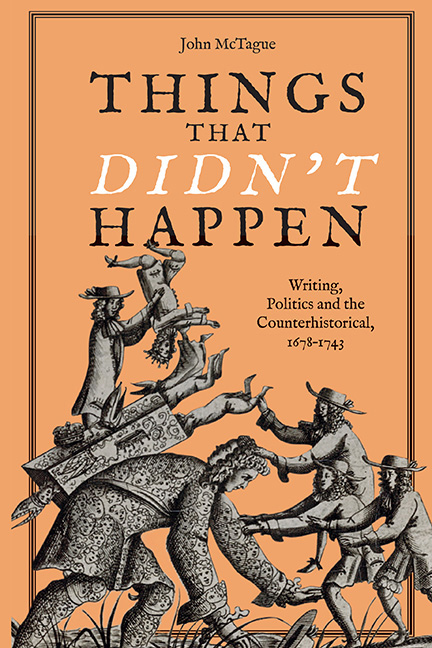Book contents
- Frontmatter
- Dedication
- Contents
- List of Illustrations
- Acknowledgements
- List of Abbreviations
- Introduction
- I Fabrications
- II Failures
- 3 Travesties: The Assassination and Insurrection Plots of 1683
- 4 Contingency and Incontinence: The Jacobite Invasion of 1708
- III Speculations
- IV The Dunciads
- Conclusion: Events that Didn't Happen
- Bibliography
- Index
3 - Travesties: The Assassination and Insurrection Plots of 1683
from II - Failures
Published online by Cambridge University Press: 09 October 2019
- Frontmatter
- Dedication
- Contents
- List of Illustrations
- Acknowledgements
- List of Abbreviations
- Introduction
- I Fabrications
- II Failures
- 3 Travesties: The Assassination and Insurrection Plots of 1683
- 4 Contingency and Incontinence: The Jacobite Invasion of 1708
- III Speculations
- IV The Dunciads
- Conclusion: Events that Didn't Happen
- Bibliography
- Index
Summary
THIS chapter deals with two overlapping conspiracies that were discovered in 1683, which are sometimes referred to with the umbrella term ‘Rye House Plot’. The first was a plan to assassinate Charles II and James, Duke of York as they returned from the horse races at Newmarket, a regular fixture in their calendar. The mooted location was the Rye House in Hertfordshire, which had been leased to Richard Rumbold, one of the conspirators. Plans to undertake this assassination in October 1682 did not get off the ground in time. Another attempt was planned for the Saturday before Easter 1683 (31 March), but a fire at Newmarket meant that the royals left the races early, arriving in London on the 27th, and the conspirators were unable to adjust to this accelerated schedule. The second conspiracy was to raise an insurrection, in various locations – London, Scotland, the West and the North of England – a rising planned by a group of aristocrats that the prosecution called the ‘Council of Six’. Although the government had information concerning the conspiracies as early as 31 March 1683, the plot was not ‘discovered’ until June, when one of the conspirators, Josiah Keeling, lost his nerve and visited Secretary Jenkins at Whitehall on the 12th. By the 19th the conspiracy was publicly known. On 20 June, warrants were issued for Robert West and John Rumsey, and their testimony led to warrants being issued for Algernon Sidney (25 June), William, Lord Russell (26 June), John Wildman (28 June), Aaron Smith (5 July), John Hampden (9 July), and Arthur Capel, Earl of Essex (10 July). A series of well publicised trials took place, beginning in July, and leading to a string of executions. Shaftesbury was involved in the plotting, but died before the discovery. Essex committed suicide (or, according to some Whigs, was murdered) in the Tower, and some, such as Rumbold, Ferguson, and Ford, Lord Grey of Warke, escaped to the continent. The Duke of Monmouth surrendered on 24 November before going into exile: his absence meant that there was insufficient evidence to convict Hampden, who escaped with a fine of £40,000.
- Type
- Chapter
- Information
- Things that Didn't HappenWriting, Politics and the Counterhistorical, 1678–1743, pp. 87 - 110Publisher: Boydell & BrewerPrint publication year: 2019



